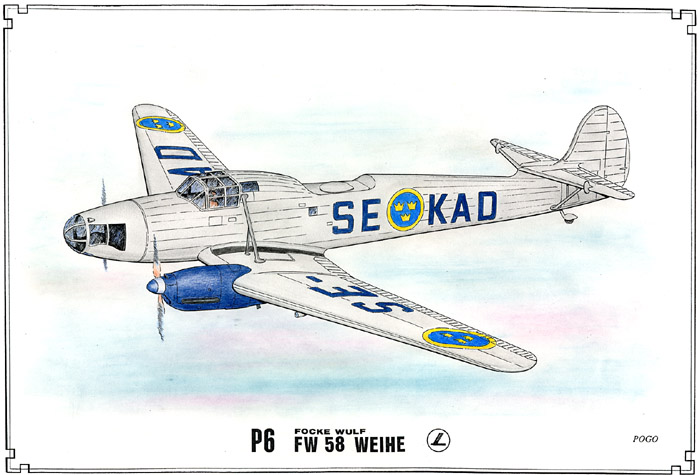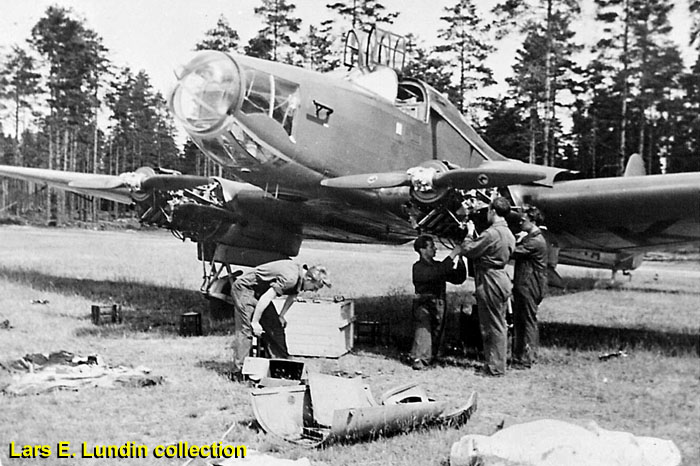|
P 6 - Focke Wulf Fw 58C-2 “Weihe” (1938-1959) |
||
|
|
Page 1 (of 2) |
|
|
|
||
|
In
1930-31, trials with mapping by aerial photogrammetry started in
Sweden. The Swedish Armed Forces had naturally a demand of maps of the
highest possible quality. In the middle to the 1930s, photographing from
the air had proved to be the best way of mapping large areas in a simple
way. With help of stereoscopy, differences in altitude could be
measured. This procedure is still in use.
The
new technique demanded not only special camera equipment but also
suitable aircraft as camera platforms. The RAK turned to Germany
to find the specialists needed to start this new activity. A Junkers W
33, specially equipped and suitable for photographing from the air, was
hired during the summer of 1937 from Lufthansa and gave some valuable
experiences. But the RAK needed more aircraft. And when the risk of a
war was becoming a reality, it was rather unpleasant to have German
reconnaissance aircraft in the Swedish territory. It was obvious the RAK needed aircraft of their own. The aerial photography required a stable and - owing to that - a relatively large aircraft. The aircraft had also to be slow in the air to give sharp photographic exposures. Soon a suitable type was found - the German Focke Wulf Fw 58 Weihe. It was from the beginning a light transport intended for the civil marked, but as the war come closer, the aircraft was adapted for military use. The “Weihe” (named after a bird, in English Harrier) was produced in the following main versions:
B-1
- The original version. It flew
for the first time in 1935 as a six-seat civil light transport, but was
also used as a trainer.
B-2
- Light bomber, equipped with
Rheinmetall Borsig MG (Maschinengewehre) 15 machine guns in a glazed
nose and in a dorsal turret, and 25 Kg bombs;
C
- Another transport variant,
equipped with doors in the fuselage sides (right over the wings). This
was the most produced variant.
Ki-2
- Civilian transport for six
passengers, with a higher rear fuselage (to give more spacious
accommodation)
S
- Ambulance aircraft (nicknamed
“Leukoplastbomber”)
BW
- A seaplane variant.
The
aircraft had a welded steel-tube fuselage, which was covered both with
duralumin and fabric. It had in some way an unusual design. The low set
semi-cantilever wings were braced from the engine nacelles upwards to
the fuselage. The tailplane was mounted forward of the fin and was braced from
below. The undercarriages retracted into the engine nacelles.
Two
Argus As 10C eight-cylinder inverted-vee air-cooled engines
powered the Swedish variant, each delivering 240 hp.
Totally
four Fw 58C were delivered to Sweden and RAK – with the restriction that
they should be used exclusively for mapping service. Two were delivered
in 1938 and 1940 respectively and were given the civil registrations SE-KAA and
SE-KAB. As the aircraft were operated by the Air Force, they also
carried the national roundel – the three crowns. They got the
designation P 6, but no individual Air Force numbers.
The
camera equipment consisted of a Zeiss Rb 20/30. The aircraft were
painted in a lighter green than usually used at this time. The underside
was light grey. A pilot and a photographer, sometimes joined by a
mechanic, manned the P 6.
The
P 6 were used intensely during the mapping season; i.e. spring, summer
and early autumn. The demand increased still more after the outbreak of
WWII. The delivery of SE-KAB in February 1940 was therefore a relief.
Unfortunately SE-KAA crashed in the summer of 1943. The crew was saved
but the aircraft was totally damaged.
Sweden
now desperately needed new aircraft for aerial mapping. Luckily for us,
Germany’s had an equivalent need for ball bearings. The annual trade
agreement with Germany secured the delivery of two new Fw 58C to Sweden
in exchange for more ball bearings to Germany. The
Swedish authorities approved the two new P 6 – SE-KAC and SE-KAD –
in March 1944. When the war was over in the next spring, the demand of
aerial mapping in fact increased. The civil market had found the
advantages of the photographic map. On the same time, the mapping
activity had got a more civilian nature. The pilots were now civilians. Some years later, also the maintenance of the aircraft was
taken over by civilian contractors. New aircraft were bought from France
(Nord NC 701 Martinet, a French copy of the German Siebel S204D) were
purchased. In Sweden, they were usually called “the Siebels”. The drawning at top by POGO shows SE-KAD, the last of the P 6s, in the end of its service (it was grounded for good in 1959). The aircraft is now re-painted in silver and, just as the “Siebels”, with registration letters and engine cowlings in blue.
The
other drawings are also made by Per Olof Olofsson, “POGO”, Trollhättan.
All photos from the collection of Lars E. Lundin, Västervik.
Length:
14,16 m. Span: 21,05 m. MTOW:
2925 kg. Maximum speed: 254 km/h. |
||
|
|
||
|
SE-KAB in flight |
||
|
|
||
|
|
||
|
Changing spark plugs on SE-KAA. Brattforsheden 1942 |
||
|
|
||
| © Lars Henriksson |
Updated 2010-07-15 |
|


